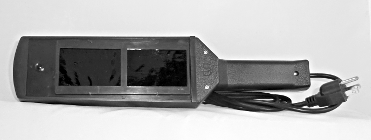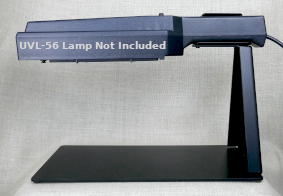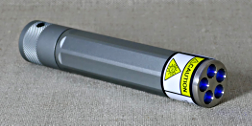Be Smart When Dealing With Art:
Ultraviolet Light Inspection
by Carol B. Carney
Gainsborough Products, LLC
Ultraviolet Light: Benefits of Inspecting Artwork with a Longwave Ultraviolet Lamp (UV Lamp)
An ultraviolet lamp is essential in evaluating all forms of artwork for their condition and age. When you are restoring, framing, buying, selling or appraising artwork, it is imperative to know if the item has been previously restored. With this information you can proceed with caution or choose to avoid inpainted areas. A restorer or framer must examine all artwork for hidden or concealed damage that might otherwise be attributed to the restorer's work. Dealers and appraisers will also benefit from the knowledge of earlier restoration when determining the value of artwork. Prior restoration can easily be detected through the use of a longwave ultraviolet lamp. In a darkened room, ultraviolet light reveals alterations such as overpainting, repairs and floating signatures on artwork that are normally invisible in daylight. The slightest alteration will stand out with extreme clarity under UV light.
For inspecting art, a longwave ultraviolet lamp in the 365-390 nanometer range should be used, with 365 nm being ideal. At this wavelength, many materials absorb invisible ultraviolet energy and transform this energy to visible colored light, easily distinguished by the human eye. It is not reflected, but emitted light. In some cases it is absorbed without emission, making these areas appear quite dark in contrast to the fluorescent areas. This makes an ultraviolet lamp an especially useful instrument in checking the condition of all forms of artwork.
Using Ultraviolet Light to Identify Repairs and Alterations in Various Forms of Artwork
Oil Paintings:
In a dimly lit room, you can show customers their artwork under longwave ultraviolet light to see if any previous restoration has been done. Using a hand held longwave UV lamp is convenient and effective. You can easily scan the entire painting and point out that dark blotches indicate repairs, floating signatures, over-painting and over- cleaning. Bluish-white spots indicate the presence of lining compound, dark bluish-violet indicates picture repair putty and very small blue dots are dust. A chartreuse haze indicates old varnish, which is what you hope to see, because it shows that no recent restoration work has been done.
It is my belief that oil paints should be used when inpainting an oil painting. However, you may find that previous restoration has been done in a variety of mediums. Glazing with oil paint is the most transparent of all inpainting, while acrylic is one of the most opaque. It is hard to tell the difference between acrylic and oil without a chemical test, but both are clearly visible. Watercolor/gouache can vary in color from pale blue to dark purple, orange, etc. Be aware that there is a masking varnish that is used to hide restoration. It has the ability to absorb the UV frequency but the surface has a greasy quality. The masking varnish is noticeable because of the density of the color and the overall perfect coating of the varnish layer.
See also “UV Inspection Photos”.
Porcelain, Ceramics & Glass:
With the use of an ultraviolet lamp, repairs and cracks in fine porcelain and ceramic art objects fluoresce bright white. Lead glass, with even as little as 1% lead, fluoresces an ice-blue color while flint glass appears white. Uranium-colored glass fluoresces a very bright green or yellow. Clear glass repairs are easily seen with the naked eye but not so in colored glass. Beware of judging the age of glass by the color, because shortwave radiation turns some clear glass to amber or purple in a matter of weeks rather than many years if aged naturally by sunlight.
Paper Art:
Under ultraviolet light, bright areas in paper art show new patches of paper. Tissue and silking repairs are also clearly visible. Smudged areas indicate erasures and very faint writing indicates erased signatures. New touch-up on watercolors and gouache has the same indications as on oil paintings. Old paper fluoresces faintly whitish, yellowish or grayish, but modern paper glows bright bluish white. Mildew (foxing) appears yellowish and makes water stains easy to recognize. Old vellum appears yellowish white or ivory, but modern vellum appears bluish white.
Textiles:
In the repair of textiles you can match the thread colors of the original piece, but the dyes of the new threads will fluoresce white under ultraviolet light where the repairs have been made.
Marble, Jade, Ivory & Clocks:
To determine the age of marble, jade, ivory and clock faces, an ultraviolet lamp is useful. Fresh cut marble will appear as a strong purple, while old marble will be a mottled white. Fresh carved jade will appear as an intense color and old jade will be mottled in color. Newly carved ivory will appear purple, but old ivory will be a yellow tone. If an antique clock has a bright white face under ultraviolet light you will know the face is not original to the case.
Additional Use for Ultraviolet Lights - Curing Glass Adhesives
When repairing glass artwork conservators often use UV-curable adhesives. There are one-part systems and two-step curing systems. Be sure to confirm the curing time with the adhesive manufacturer. Gainsborough's UVL-56 (6W Hand Held Ultraviolet Lamp, 365 nm) placed in the J-129 Lamp Stand is very effective for the curing of UV-curable adhesives and has a fixture time of 45 seconds and a full cure time of 100 seconds at an intensity of 1,350 microwatts per centimeter at 3".
Recommended Longwave Ultraviolet Lamps Available from Gainsborough Products, LLC
 UVL-56: 6W Hand Held Electric UV light, 2 lb.
Excellent UV light source for use in the workroom.
UVL-56: 6W Hand Held Electric UV light, 2 lb.
Excellent UV light source for use in the workroom.
 J-129: Stand for UVL-56 Hand Held Electric UV light. (J-129 Does Not Include UV Lamp)
J-129: Stand for UVL-56 Hand Held Electric UV light. (J-129 Does Not Include UV Lamp)
 UVL-4P: 365-400 nm UV LED Lamp, CR123A Battery Operated. Strong flood illumination in a portable format. Great for onsite visits, galleries and auctions.
UVL-4P: 365-400 nm UV LED Lamp, CR123A Battery Operated. Strong flood illumination in a portable format. Great for onsite visits, galleries and auctions.
